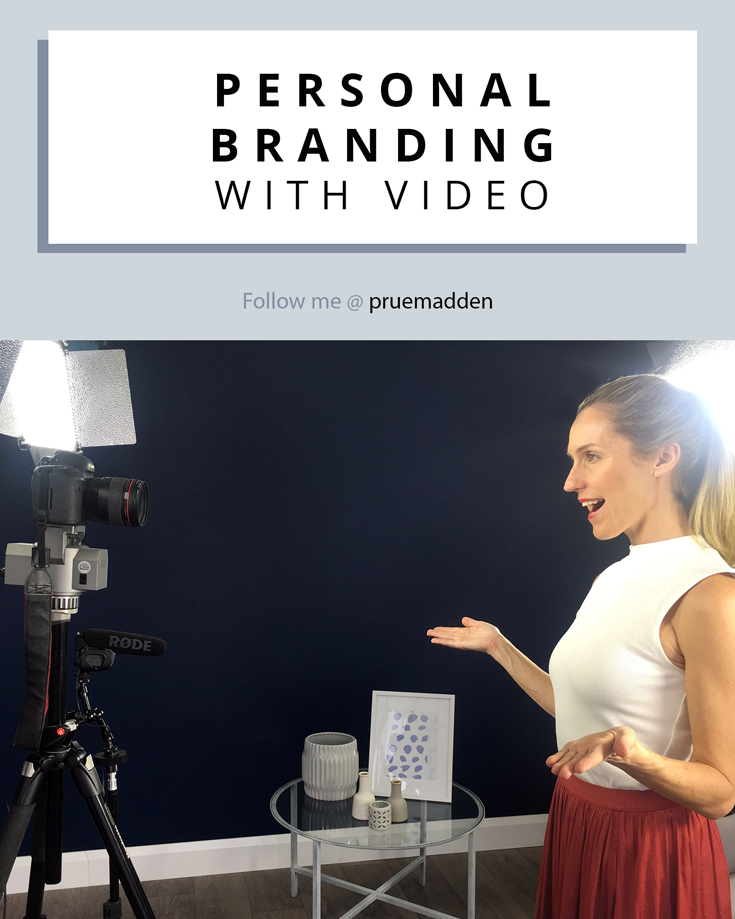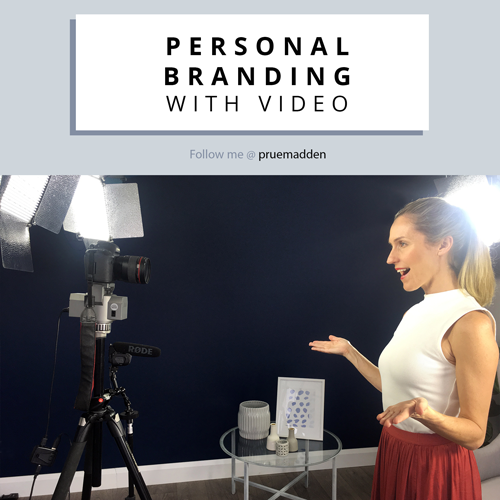
Almost every individual has a ‘personal brand’ – whether you’ve purposely designed and built it or not.
So what is Personal Branding, and how can we use video to cultivate and support a positive personal brand online?
Personal branding is the ongoing process of creating an impression in the mind of others about ourselves. It is the association that people develop to your name.
Successful personal branding requires significant self-awareness, determination and continual effort.
It is an ongoing endeavour, and therefore requires ongoing self-discipline to maintain.
Today I want to talk about how you can use video to build your personal brand online.
So every video, whether it be pre-recorded or livestream, adds to the collage that becomes the association that people have when they hear your message or think of you or your name.
Because of this, before you go out and start shooting video after video, it’s important to have a clear picture of your personal brand, and of your goals and objectives with your online video ecosystem.
So let’s get started using video to build an online presence that has your target market coming to you.
First up, let’s start by defining 10 elements that make up your personal brand.
1. Define you Personality
Defining your personality from a second person perspective can be a tricky exercise. You can’t do this on your own. This is where you need to enlist the help of others. What are the characteristics that affect the experience someone will have with you? Are you humorous? Motivational? Calming?
Ask your friends, family and colleagues / ex colleagues to describe these features of your personality. How you make people feel?
Ask two friends.
Ask 2 colleagues / ex colleagues
Ask 2 family members
Make note of their feedback as a word list. Distill this list of words down to 3 words that best describe you in a positive light, according two others. Which 3 words were most frequently used, that you are happy to work with as your key characteristics?
2. Values
Your values guide how you feel, behave and react. When you are in good space, and your situation is aligned with your values, you feel confident, happy, motivated and able to connect with others.
You values are your operating principles, and they affect how you treat others, and approach life and work.
Injecting your values into your videos by choosing content topics based around these values will create a body of work helps your audience get a broad understanding of what your personal brand stands for and what you are all about. This body of work will attract and audience who has similar values to you.
3. Interests & Passions
Interests and passions are a big part of what makes you, you! They add colour and character, and help people relate to you. When you talk about your interest, a spark lights a up your face and you talk with passion. If you can find a way to link your passions to your work – even just to paint a picture when story telling, it makes you attractive, makes your story relateable to your audience, and generally adds more interest to your content. Not only that, in makes you human.
4. Goals
Understanding of who you are, and what you stand or can assist you in figuring out where you want to go. It’s important to have goals before you start sending your videos out into the online world. It’s also important to understand that goals can change over time, so don’t let fear stand in the way of your goal setting and stop you from creating video content.
You’ll need an overall goal for your video strategy – for example you need to know what do you want to achieve with your videos, what platforms will help you achieve this. Is video supporting your other content? Is video the main vehicle for your content?
Then, on a more micro level, you need to know the goal for each and every video you make. Are you wanting to achieve brand awareness, traffic, engagement, thought leadership, lead generation or conversions?
5. Strengths & Weaknesses
When branding with video, it’s obvious that you are going to be on show. It’s time to define your strengths that you can tap into to deliver best your messaging. Consider your grooming and style, tone of voice and delivery style, your body language. Get on camera and do some test runs, watch the videos back and pinpoint your strengths and your weaknesses.
Here’s what you need to consider when workingon your confidence, and your delivery.
Choosing the right clothing and makeup
Connecting with your audience
Tone of voice, diction and delivery
Breathing and vocal control
Working with a script
Struggling with introversion
Developing confidence
6. Authority through experience
Storytelling is the key to educating, and showcasing your experiences and expertise. By selecting the right stories, you can drive a point home and at the same time, demonstrate your experience and your knowledge so that you can carve out your place as an authority in your niche.
Have you every come across someone in a social situation that spouts off about how wonderful they are, and how much they know? Icky right? It makes you want to move away from and now toward them, am I right?
Well stories are a powerful way to say hey, I’ve been there, look at what I’ve done, without sounding like a bragger. Show, don’t tell.
So once you’ve figured out your brand, and you’re ready to start creating videos, strive to frequently recount stories and experiences that will help you present a point, and showcase your authority and experience. Remember though, your stories are these with the primary purpose to educate, and the authority that you display is a bonus.
7. Role Models and Inspirations
Who has inspired you along your path to do what you are doing? Create a summary of their achievements, and use this to help you define your own unique journey that you aspire to take. If you have more than one role model, this gives you a wider pool of inspiration that you can dip into to create your own unique journey.
Don’t be afraid to reference these people in your videos, and certainly don’t be afraid to discuss your aspirations. Everyone who watches will have their own unique inspirations, and the fact that you have yours too makes you more relatable and attractive.
8. Your Look and Style
You never get a second chance to make a first impressions. Considering many people who come across your videos online will find you through a video on Youtube, Instagram, Facebook, or another social channel for their first time, you need to ensure that you are making a good impression every time.
An impression is established in the first seconds of meeting you, and are based on what they see, how you act, and what you say. What they see is incredibly important, so make sure you make an effort to look good. If you look good, you will feel comfortable, and this will give you confidence. And confidence is attractive, right?
No matter what your personality or your niche, you should develop your own personal “dress code” that’s tied to your personal brand and goals.
First of all, you need to understand who your audience is kind of message you want people to get when they watch your videos. You don’t need to splash out on latest trends each season, but you need to be well presented and consistent with your brand.
If you are selling dog training, you’re going to have a very different tone, voice and look to someone who is in the yoga niche. If you are selling marketing training to stay at home mums, your attire will be quite different to the clothing you would wear if you are selling marketing training to the corporate market. The commonality across all niches, however is that you need to be presentable, clean, and show that you care enough about your brand and your viewers to show up on their screen looking like you have made an effort.
Keep your styling consistent. Varying your styling too much can lead to confusion for your viewers. If you are going to go for business wear, stick to that styling. Don’t do business wear one day and casual the next.
Think about the descriptive terms that could be used to describe your brand. Some examples may be stylish, beachy, powerful, polished, fitness, timeless, feminine, masculine, fresh, casual, edgy, classy, chic, stylish and polished. Choose 3 words that best describe your style that you will wear when representing your brand on camera. Regardless of whether your setting requires you to wear casual or formal clothes, you can keep these three words in mind when you are selecting your wardrobe.
Keep in mind that while your style is important, it’s important to make sure that your clothing does not draw too much attention away from your face and what you are saying.
Avoid stripes and heavy polka dots, and keep your make-up and hair natural, unless of course, your personal brand is all about pushing the limits and flipping your finger at cultural norms. Then of course, your personal brand may call for you to go against some of these rules!

